By Mike Brusov
Watching Bitcoin in December 2017, do you remember feeling quite sure that this is just a short-term downslide? January 2018: a month has passed, but your hopes were still high.
In retrospect, we see all the figures and prices and find that the new trend was obvious: normal price behavior dictates that a period of parabolic growth normally ends with a price correction. This price behavior is a very common market phenomenon dating back to the early 1700s when the ancient Japanese method of technical analysis (called Japanese Candlesticks) was used to trade rice contracts.
So what was on the mind of traders and analysts before and after this series of events in the crypto market? What was the general sentiment and mood? Nine months of our research showed that it took two months to adjust to trends that were long ago technically and fundamentally confirmed. Two months, really?
Emotions in trading
Why did it take so much time to accept the reality? Emotions, a lasting euphoric mood, naïve expectations and hopes for a BTC price increase were very familiar to any active crypto investor.
If you could track all of your predictions and actual outcomes, the picture would probably not be very pretty. As humans, we’re all highly biased. We unconsciously seek information that can prove that we’re right (confirmation bias). We believe CEOs we like regardless of what’s happening with the company (just try shorting Tesla). And we don’t listen to the opinions of people we don’t like even when they’re right.
These emotional biases are particularly strong in crypto markets. Many projects are based on strong ideas: decentralization, privacy, censorship resistance. Crypto assets are not only about money, for many people they represent a better future. It’s hard to disentangle your desired vision from the current price, which is the sum of the market’s expectations for the future.
In our research, we found that market watchers continued to stay bullish for roughly two months after the onset of bear trends. For instance, the collective mood adjusted only in March, after the overall market capitalization declined from the January high of $835 billion to below $300 billion in February.
Now you begin to understand why markets are so irrational and unpredictable. This resulting uncertainty makes it very hard to make correct decisions and often leads to substantial losses. Even the best traders are not immune to emotional swings.
Artificial Intelligence for trading
If traders and investors are bad at decision-making, can AI replace humans? Well, the term Artificial Intelligence itself is a misnomer. It is artificial, but it’s not really intelligent. “Machine learning” is a more appropriate term.
Compared to humans, machines are better at processing large volumes of data. You can apply machine-learning algorithms to data sets with historical asset prices. Or you can try to find different correlations between asset prices and some other data sources. You can also use machine learning to remove biases from human-generated data, such as Twitter feeds or your own forecasts. The catch is that you need really big data.
Neural networks, which is what most people mean when they talk about AI, require even bigger data sets. These models “learn” by identifying complex, non-linear relationships between different elements. Typically, even their creators don’t fully understand how exactly they work. One connection is very clear: the more data you have, the more accurate a neural network can become.
Learning from traditional finance
Using statistics and machine learning in finance is nothing new. Quantitative trading hedge funds that use statistics to find an edge now manage almost $1 trillion in assets. It’s an established field that poaches some of the best minds from across the scientific and tech worlds.
These strategies, however, cannot be easily transferred to crypto asset trading. The crypto market is simply too young and there are almost no reliable data sources. Most quant strategies at least partially rely on public data: price and volume history, regulatory filings, official press releases.
Have you seen any of that reliable and public data in crypto? That’s right, there is almost none. Even the validity of exchange feeds is questionable. So what would you feed to your machine learning models?
We think the crypto industry will follow the footsteps of traditional finance. The regulation will eventually arrive and investors will increasingly rely on statutory public data. That may take years, however. Hopefully, we won’t need to experience a crash similar to the one that happened in 1929, which preceded the establishment of the US Securities and Exchange Commission.
Ever since the SEC brought order to financial disclosures, investors have also been searching for alternative data sets. In the pursuit of alpha, equity and credit hedge funds trawl through satellite imagery, credit card transactions, social media content, and even garbage. Some teams in crypto, including ours, are also building our own data sets. In fact, that’s probably the only reliable data in crypto right now.
As of today, the machines cannot make crypto trading decisions for you. First, there is simply not enough data. And even with the ample supply of data, the machines can only augment your thinking by processing the data more efficiently, creating something that we call Hybrid Intelligence. Yet you, as a trader or investor, still have to make the call.
Mike Brusov is co-founder and CEO of Cindicator and a tech entrepreneur with nearly a decade of experience in launching companies in big data and predictive analytics.
















